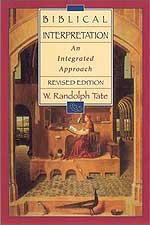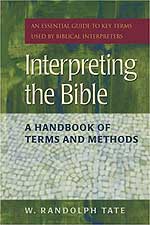 In the past when I taught the introductory hermeneutics course at Taylor, I used ‘s Biblical Interpretation: An Integrated Approach (Revised Edition; Hendrickson, 1997; Buy from Amazon.ca or Amazon.com).
In the past when I taught the introductory hermeneutics course at Taylor, I used ‘s Biblical Interpretation: An Integrated Approach (Revised Edition; Hendrickson, 1997; Buy from Amazon.ca or Amazon.com).
I found that its engaging, easy to read style — as well as its review sections and study questions — made it an ideal textbook for undergraduate students. I especially appreciated Tate’s theoretical basis and how he organized the book into three major sections: world behind, within, and in front of the text (although I structure my class a bit differently, starting by getting students to recognize their own presuppositions). I am planning on using Tate again this upcoming fall when I take over teaching the introductory course in hermeneutics and method (unless, of course, someone alerts me to a more suitable textbook).
I was pleased to see that Tate has produced a companion handbook to his text:
 Interpreting the Bible: A Handbook of Terms and Methods
Interpreting the Bible: A Handbook of Terms and Methods
Hendrickson, 2006
Buy from Amazon.ca or Amazon.com
One of the constant problems in entering any new academic discipline is learning the jargon and technical language that people within that discipline use — and biblical studies is no different. This work is a guide to the key terms and theories used in biblical interpretation. From a quick flip through I found the Handbook to be quite exhaustive, particularly in regards to the more theoretical side of biblical interpretation. Thus, if you ever wanted to know the difference between Langue and Parole, or what ideological overcoding entails, or transactive criticism is, then this book is for you.
That being said, its focus is more on terms relating to biblical interpretation, not biblical studies in general. Thus, while it covers much the same territory as ‘s Handbook of Biblical Criticism (3rd ed.; Westminster John Knox Press, 2001; Buy from Amazon.ca or Amazon.com), it includes far more discussion of more recent interpretive terms and methods. On the other hand, there are some discussions which I would like to see expanded a bit (see “lament”) and others included (e.g., terminus ad quem and terminus a quo, palistrophe, etc.).
All in all, this work appears to be a very useful resource for students and scholars alike. Next time I am trying to figure out what the heck polypoton is, I know where to look!

Somehow these resources by Tate have slipped my attention but they look like valuable resources–thanks. I suspect Jeannine K. Brown’s forthcoming book Scripture as Communication: Introducing Biblical Hermeneutics will be helpful for undergraduate and graduate students wrestling with the difficult issues of hermeneutics.